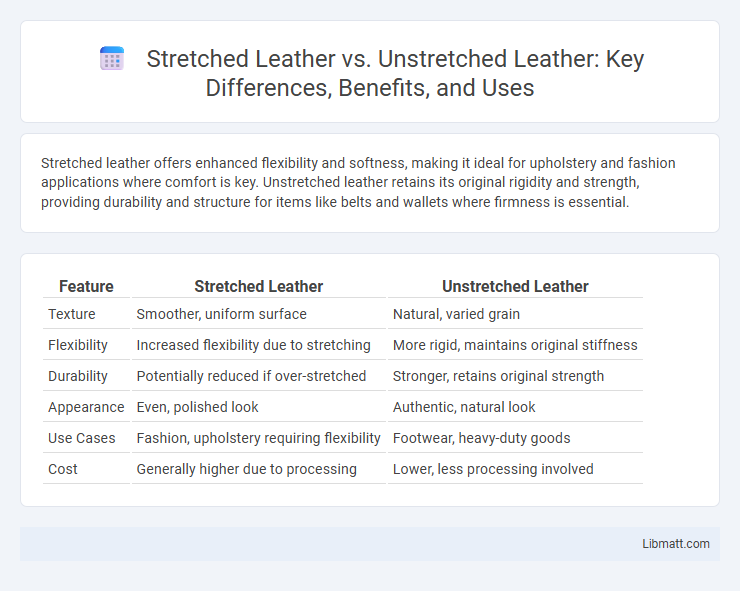Stretched leather offers enhanced flexibility and softness, making it ideal for upholstery and fashion applications where comfort is key. Unstretched leather retains its original rigidity and strength, providing durability and structure for items like belts and wallets where firmness is essential.
Table of Comparison
| Feature | Stretched Leather | Unstretched Leather |
|---|---|---|
| Texture | Smoother, uniform surface | Natural, varied grain |
| Flexibility | Increased flexibility due to stretching | More rigid, maintains original stiffness |
| Durability | Potentially reduced if over-stretched | Stronger, retains original strength |
| Appearance | Even, polished look | Authentic, natural look |
| Use Cases | Fashion, upholstery requiring flexibility | Footwear, heavy-duty goods |
| Cost | Generally higher due to processing | Lower, less processing involved |
Introduction to Stretched and Unstretched Leather
Stretched leather undergoes a mechanical process to expand its fibers, enhancing flexibility, durability, and texture, making it ideal for high-end upholstery and fashion applications. Unstretched leather retains its natural grain and rigidity, offering a more traditional look and feel, typically preferred in classic leather goods such as wallets and belts. The choice between stretched and unstretched leather depends on the desired elasticity, finish, and end-use requirements in leather craftsmanship.
Defining Stretched Leather: Processes and Characteristics
Stretched leather undergoes a controlled mechanical process where the hide is pulled over molds or frames to enhance flexibility and smoothness, improving its durability and aesthetic appeal compared to unstretched leather. This process alters the grain structure, resulting in a more supple texture and resistance to creasing, making it ideal for high-quality upholstery and fashion applications. Understanding the differences in texture and performance can help you choose the right type of leather for your specific needs.
What Is Unstretched Leather? Key Features
Unstretched leather refers to natural hide that has not been pulled or expanded during the tanning process, preserving its original texture and thickness. Key features include a dense grain structure, enhanced durability, and a more rigid feel compared to stretched leather. Your choice of unstretched leather ensures a sturdy and authentic material ideal for projects requiring firm, traditional leather characteristics.
Differences in Appearance and Texture
Stretched leather exhibits a smoother, shinier surface with reduced grain visibility due to the tension applied during stretching, which tightens and flattens the fibers. Unstretched leather retains its natural, irregular texture with pronounced grain patterns, showcasing a more rugged and matte finish. The tactile experience of stretched leather is firmer and less pliable, whereas unstretched leather feels softer and more supple, reflecting its untreated flexibility.
Durability: Stretched vs Unstretched Leather
Stretched leather generally exhibits increased durability due to the fibers being aligned and compacted, enhancing resistance to tears and wear. Unstretched leather, while naturally flexible, tends to have a more relaxed fiber structure that may be more susceptible to deformation and early signs of aging. The manufacturing process and intended use significantly impact the performance differences observed between stretched and unstretched leather types.
Common Uses and Applications
Stretched leather is commonly used in upholstery, fashion accessories, and high-end furniture due to its enhanced durability and smooth finish, making it ideal for items that require a consistent texture and longer lifespan. Unstretched leather finds applications in footwear, gloves, and small leather goods where flexibility and natural grain are prioritized, providing a more authentic and softer feel. Your choice between stretched and unstretched leather should consider the specific durability and aesthetic requirements of the intended product.
Performance in Craftsmanship and Upholstery
Stretched leather offers enhanced durability and resistance to deformation, making it ideal for high-performance craftsmanship and maintaining shape in upholstery projects. Unstretched leather retains a more natural texture and flexibility, allowing for intricate detailing but requiring careful handling to prevent sagging or wear over time. Your choice between these leathers impacts the final product's longevity and aesthetic precision.
Care and Maintenance Considerations
Stretched leather requires gentle cleaning with a damp cloth and conditioning every 3-6 months to prevent cracking and maintain flexibility, while unstretched leather can tolerate more frequent conditioning due to its firmer structure. Avoid exposing stretched leather to direct sunlight or heat sources, which can cause irreversible deformation, whereas unstretched leather is more resistant to shape distortion. Proper storage on padded hangers preserves your stretched leather's contour, but unstretched leather benefits from breathable covers to prevent moisture buildup and mildew.
Cost Comparison and Value
Stretched leather typically incurs higher costs due to the additional processing and finishing techniques that enhance its durability and aesthetic appeal, making it a premium choice compared to unstretched leather. Unstretched leather is generally more affordable but may lack the refined texture and longevity associated with stretched variants, impacting its overall value. Consumers seeking long-term investment and superior quality often find stretched leather offers better value despite the higher initial price.
Choosing the Right Leather for Your Project
Stretched leather offers enhanced flexibility and durability, making it ideal for projects requiring a snug fit or added resilience, while unstretched leather retains its original texture and firmness, perfect for crafts needing a more rigid structure. Your choice depends on the specific demands of your project, as stretched leather adapts better to contours and movement, whereas unstretched leather maintains stability and shape over time. Selecting the right leather type ensures optimal performance and longevity for your finished product.
Stretched leather vs unstretched leather Infographic

 libmatt.com
libmatt.com